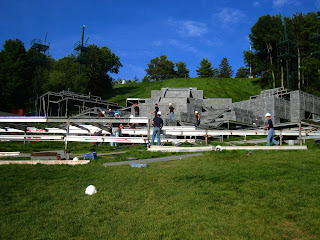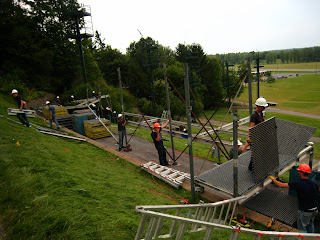
Brother Lyman also made a whale-looking fish named Wiggles. Wiggles was launched out of a cannon every single show, leaving us the game of finding Wiggles after the show was over! I found him once :D
My fun during the show involved my camera, of course. I had to smoke stage 4 during the Nephite/Lamanite battle scene and noticed the light rays coming through the fibergrating were awesome! I took advantage of this on the last two nights and tried out some photography.


I have plenty more photography shots that will be posted on here in the future (or you can sneak-peek them at my deviant page!).
While we were taking down the stage, we were visited by Moroni the cat.
Apparently this cat has stayed around the hill for a few years now and is still doing ok. I'm told the sister missionaries at the visitor's center keep him well fed :P
I also haven't mentioned the fact that the workcrew members are treated as celebrities by the cast and staff. We sat in the front of every devotional meeting. Not the front row--we were in front facing the cast and sitting next to the pageant presidency and the directors! The first time we saw the cast at the first devotional, we were applauded for as we walked in. Even the primary kids would often start chanting "Work-Crew!-Work-Crew!-Work-Crew!" Of course, we would follow up with "Pri-mary!-Pri-mary!-Pri-mary!" I absolutely loved the kids--you couldn't help but smile and just be happy around them. We drove over with our tractor and trailer, picked up the kids, and gave them a ride for a little bit in the field.
Brother Krebs told them that our tractor was a funky one, in that it only went faster if it heard louder singing. So of course, we spent the next 20 minutes just riding around with all these kids singing whatever church song they pleased. I definitely thought we could've gone longer. The kids thought so too:
We got to witness 2 mission calls during the experience as well!
Congratulations to Brother Gassoway for his call to Cebu, Philippines and Brother Nelson to his call to Sao Paulo, Brazil! For both calls we travelled to the top of the hill. We also would go to the top of the hill whenever we hit a major transition in roles, such as switching between construction and tech crew or as we were finishing up our experiences in Palmyra.


The Wind Tunnel served as our home.
I often describe it as a glorified garage. It's located behind the hill. The picture shows the front entrance, which leads to a "day room". Pretty much only us boys were allowed past this room. We also had a big bathroom and the wind tunnel itself.
If you've ever seen The Newsies, this reminded me a lot of how the opening scene feels. I took this picture standing on my companion's bed, which is above my bed. You'll notice the door on the far left: it led to a few washers and dryers--yes, we did try to keep ourselves and our clothes clean during the month.
This was our backyard, home to many cornhole games. It's quite a simple game: 2 teams of 2 alternate tossing beanbags onto a board (shown in blue). You score 1 point if you get on the board and 3 points if you get it into the hole. We also played plenty of other games too, ultimate frisbee being a frequent one.
We ate very well at the hill too. We actually had a personal caterer for the whole month. I'm quite impressed at the meals that we had. Here's a pretty average-looking dinner for us:
Can you believe I still haven't gained weight?! :D
We were involved in a few competitions at the hill as well. The workcrew holds a little mail competition for the month.
Here's our point system. A letter without a stamp usually came in the form of a note from a cast member. However, if the cast member was a girl, you got 15 points, period. I ended up with 203 points by the end (thanks for those that wrote! :) ) I was a little below-average from the rest of the boys though. Some were just absolutely spoiled. Some actually had like every young women in their home ward write them a letter, which majorly boosted their points.

Don't mind the doodles: This was taken on the last day and they went on a drawing craze that night.
The Golden Spoon award went to the winner of the annual bake off competition between the cast. The judges just so happened to be the work crew ;) We actually had over 40 entries this year. We had sooo much food!!! Pretty much all of it was amazing too. We had to create 2 food categories because there was so much food! I loved it though :) I got to draw the winners on the board too.










































